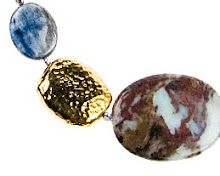
People are allergic to metals for 2 main reasons; nickel and, less often, from salts leaching out of copper. Nickel is the main concern with roughly 12% of all women and 6% of males are allergic to nickel. Furthermore, even people with no history of nickel allergies will develop them over time if their skin makes regular contact with nickel. Most metals used in jewellery making such as silver, gold, rhodium, platinum or palladium are not known to cause allergic reactions in their pure forms. However, these metals are commonly alloyed with other metals to reduce cost, to make the metal more durable or to make the metal easier to work with.

Semi-precious and fashion jewellery comes predominately in a gold or silver tone. For gold tones, it can be karat gold, gold-filled, or achieved with gold plating over a base of sterling silver- a process known as gold vermeil- or, simply brass coated with clear lacquer. Brass, even with lacquer coating, is never recommended for jewellery making because it tarnishes extremely quickly and discolours to a patina green or black and leave marks on the skin. Copper has a fairly good reputation among people with sensitive allergies, but it too can generate rashes on the skin of the wearer as a result of the salts that are gradually teased out of the metal, causing dermatitis with prolonged exposure.
While karat gold and gold-filled can be brought back to their original shine, plated metals can not, and more people tend to be allergic to plated jewellery. Plating is thin and comes off easily with wear, and also there is leaching of the base metal. For these reasons, is not recommended for better quality or hand crafted jewellery. It is most often used in imported and low-end mass market jewellery.

Since people aren't allergic to gold but rather the base metals it is alloyed with, high purity is ideal. The higher the karat, the more pure, the fewer people are allergic to it. Unfortunately a person with a strong sensitivity to nickel will find that even 18 karat gold may be totally unwearable- after all, it is still only 75% pure gold. The same holds true for gold-filled, which also has different levels of gold purity.

Silver tones in jewellery are most commonly achieved with sterling silver, nickel-plating over a base metal, or pewter with a lacquer coating. Pewter has a steel grey colour, which is not desirable for some markets. It is a popular casting metal, but it is also soft, making it a less favourable metal for findings such as earring hooks and clasps. Pewter has a remarkably clean allergy track record, and problems only arise when the metal is alloyed with, surprise surprise, nickel. Many manufacturers go out of their way to notify clientele that their pewter is nickel-free, and you shouldn't be shy about inquiring if you are ever unsure.
The same people who react to low-karat gold jewellery will almost certainly also react to cheap silver jewellery, a function of the same culprit: nickel. Silver-looking articles sold for bargain prices have been found to contain as much as 78% nickel, sometimes coated with a silver layer that unfortunately does little to protect the skin of the wearer. Even worse is nickel silver, or so-called German silver, which is 90% nickel and 10% tin. Nickel is incidentally also responsible for occasional allergic reactions to surgical grade stainless steel (8-12% nickel), which for that exact reason is rapidly being replaced by titanium for body implants and orthodontic work.
Sterling silver, finally, is also sometimes partly alloyed with nickel, but has rarely been known to cause breakouts or rashes. This is the case because sterling silver is still (by definition) 92.5% pure, with the remainder usually accounted for by copper, which in such small concentration has never been reported to cause skin maladies. In cases where nickel is used as well as copper to make up sterling silver's remaining 7.5%, the percentage is still far too low and inactive even to offend the skin of someone with strong nickel sensitivity.
When gift giving, you should always be sure how sensitive the intended recipient's skin is. When designing for resale, one should always be conscious of perceived value. Sterling silver and gold are much more popular and this value will translate into more sales. If time and effort is to be invested in a unique design and hand crafting, one should use only sterling and karat or gold-filled metals.

No comments:
Post a Comment